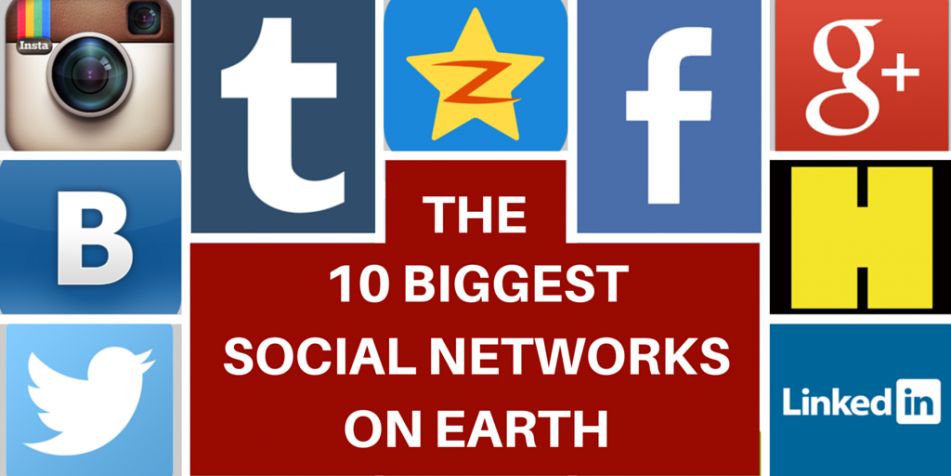Does size matter?
It’s an eternal question for Cosmopolitian magazine but, when it comes to social networks, the answer is surely YES.
Every social network begins with a single user. And all hope to expand to the point where that single user it but one of hundreds of millions.
But few get to that point, and the ones that do dominate the social media landscape in a way that their smaller competitors can still only dream of.
In this post we count down the 10 Biggest Social Networks on Earth that, combined, represent more than 5,5 billion user accounts.
Whether you have an account on every one of these networks or whether you’re still only just dipping your toe in the social ocean, here are the ten biggest social networks on the planet today.
Ranking the 10 Biggest Social Networks
Ranking the social networks by their user base is not all that complicated. Find the ten biggest social networks and list them in reverse order – simple, right?
But there are bound to be a couple of networks that are unfamiliar. Maybe their user base is regionally or linguistically focused somewhere where your focus is not. Or maybe it attracts a user that is older or younger than you.
To help you find your way through the list, then, we’ve added some additional information to provide a slightly broader picture of these networks.
You’ll see when they were launched, the sort of user they attract, whether they are regional or global concerns, why people join, and prospects for the network in the near future: are they getting stronger, weaker, growing, shrinking, or are they ready to explode?
Here in the DOZ office the average team member is present on about five of these ten social networks – how about you?
10: LinkedIn 200 million users
Who: Adults (18 years and older)
Where: Global, though far more popular in North American and Europe than elsewhere
Why: Professional networking
Future Prospects: Strong in their niche. LinkedIn is the default social network for professionals in the West and while there are some regional challengers in France and Germany, LinkedIn has attracted a global user base willing to pay for their professional networking opportunities.
9: Tumblr 225 million users
Who: Open to all, trends younger
Where: Global
Why: Microblogging and sharing microblogs of others
Future Prospects: Tumblr is simple to use and makes sharing simple, too. Blogging and reblogging takes only a click, and building a Tumblr profile is the work of seconds, not minutes or hours. Tumblr powers some important blogs on major media sites, but suffers from a reputation that has been strongly influenced by a user base that trends towards the younger, less mature end of the spectrum. Relatively recent attempts to monetize the platform with advertising, though, have been somewhat successful so, for the moment, Tumblr is here to stay.
8: VK 250 million users
Who: Open to all
Where: Global, but trends towards Russia and former Soviet republics
Why: General social networking, photo and music sharing
Future Prospects: VK has established itself as a force to be reckoned with in the Russian speaking world. While sometimes referred to as ‘the Russian Facebook’, VK established itself as the market leader in Russia and the former Soviet republics and pushed Mark Zuckerberg’s global juggernaut into second place. Long term – and as the Russian market becomes more important to Facebook – VK may face stiffer competition, but its early-mover advantage will be hard to shake.
7: Habbo 270 million users
Who: Teenagers
Where: Global, with separate language and national communities
Why: General gaming and virtual social networking
Future Prospects: It’s difficult to see a long future for Habbo, at least relative to the other social networks on this list. Their teenage user base eventually tires of the gaming and the networking and moves out of the network, and Habbo relies on attracting younger users to replace them. If tastes in social networking change, technology overtakes what Habbo can offer, or if teenagers move away from the gaming side of Habbo altogether, then Habbo is toast.
6: Instagram 300 million users
Who: Anyone 13 years and older
Where: Global
Why: Image sharing
Future Prospects: Facebook saw the potential of Instagram and paid a pretty penny – $1 billion in pretty pennies, actually – to purchase the social network in 2012. This injection of capital, knowledge, and support pretty much guarantees that Instagram is set moving forward and there’s little chance that it will collapse anytime soon. More importantly, though, Instagram is getting its advertising and eCommerce elements in order which means sustainable revenues are (hopefully) not too far around the corner.
5: Weibo 300 million users
Who: Open to all
Where: Primarily China
Why: Microblogging, social sharing, social networking
Future Prospects: The future for Weibo is both strong and weak. It’s strong because with a user base of more than 300 million people and a an ‘in’ with the government in China (and a proven willingness to censor content when required by the Chinese Communist Party) there is some incredible traction from an early mover. On the other hand, Weibo’s expansion outside of China is limited to the Chinese speaking world, with the odd celebrity or politician seeking an outlet to speak to the Chinese people somewhat directly not withstanding. One to watch, in any case.
4: Qzone 480 million users
Who: Open to all
Where: Primarily China
Why: Social networking, image sharing, music sharing
Future Prospects: Qzone is to Weibo as Facebook is to Twitter: it’s not microblogging but a more traditional social network. Users are active, spend money on the platform, and this creates some real traction for the company moving forward. While it is limited in its geographic scope – again, confined mainly to East Asia – the company’s revenue streams are positive signs for the future of the network.
3: Twitter 645 million users
Who: Open to all
Where: Global
Why: Microblogging and social sharing
Future Prospects: Strangely for a network that has more than a half billion users, Twitter’s future is far from assured. While it has established an incredibly high profile in the mainstream media and around social, political, and cultural events, Twitter has failed in attempts to monetize its platform thus far. Promoted tweets and advertising are creating revenue streams, but there are doubts in some quarters as to whether these streams will grow to the point where Twitter can prove its worth as a company valued at more than $8 billion by investors. Call it a 50/50.
2: Facebook 1.3 billion users
Who: Anyone 13 years or older
Where: Global
Why: Social networking, image sharing, gameplay – almost anything
Future Prospects: The grand-daddy of social networks, Facebook is not going anywhere anytime soon. With a global footprint (save for a few countries where governments do not allow the American giant to operate freely) and a global brand to match, Facebook dominates social networking in a way that other networks can only dream about. When Facebook can buy up a social network like Instagram – also on this list – and still have billions to spare, it has established itself as a true technology giant. Facebook will continue to evolve, but it won’t disappear.
1: Google+ 1.6 billion users
Who: Anyone 13 years or older
Where: Global
Why: Social networking, and because you were forced to join
Future Prospects: Weak. Does that sound strange? The world’s biggest social network with more than 1.6 billion users and we’re saying it has weak prospects? Sad, but true. Google+ has a large user base by virtue of Google’s own large user base for other Google products. Forcing users to join Google+ or pushing an account on them that sits largely dormant – effectively taking the ‘social’ out of ‘social network’ – means Google+ can claim a massive user base without the associated massive interaction. Unless Google gets serious about social, there’s not much hope that Google+ will ever be much of a force.
How many of the top 10 social networks on this list do you have an account? Is it more or less than our average of five in the DOZ office? Let us know in comments below!













128 Comments
https://tinyurl.com/yzdex8za https://Bit.ly/3PoGJ9l https://tinyurl.com/bd8nh7hh https://Tinyurl.com/356m4924 https://cutt.ly/5HvvEZ1 http://e-ubezpieczenie24.pl https://is.gd/EF7Nxb https://tinyurl.com/yck5ywku https://is.gd/P7qT0L https://rebrand.ly/f22a04
https://Tinyurl.com/2d6kc7z4 http://tewaubezpieczenia.pl https://bit.ly/3LjUJhr https://rebrand.ly/3a55b3 http://Ubezpieczsieteraz.pl/ https://is.gd/6g4B4T https://rebrand.ly/7a1275 http://ubezpieczenia-jaworzno.pl https://rebrand.ly/86dbc4 http://Ubezpieczenieprzezinternet.pl
bit.ly noweubezpieczenia.pl https://is.gd/4dfpJm tinyurl.com
cutt.ly https://cutt.ly/lHvcG1y https://rebrand.ly/72e1dd tinyurl.com
https://tinyurl.com/3xecpk7z http://ubezpieczeniaporeba.pl ubezpieczenie-przemysl.pl https://bit.ly https://tinyurl.com https://Is.gd/TaQHS4 cutt.ly Is.gd
I have read your article carefully and I agree with you very much. This has provided a great help for my thesis writing, and I will seriously improve it. However, I don’t know much about a certain place. Can you help me? https://www.gate.io/uk/signup/XwNAU
Sutter Health
Good way of explaining, and fastidious article
to obtain facts concerning my presentation subject, which i am going to present in academy.
Asking questions are actually pleasant thing if you are not
understanding something totally, but this paragraph provides good understanding even.
Nice replies in return of this issue with solid arguments and explaining the whole thing on the topic of that.
Hey there! Someone in my Facebook group shared this website with us so I came to give it a look.
I’m definitely loving the information. I’m book-marking and will be tweeting this to my followers!
Exceptional blog and fantastic style and design.
Hello! I’ve been reading your site for a long time now and finally got the bravery to go ahead
and give you a shout out from Huffman Tx! Just wanted to tell you keep
up the excellent work!
Its like you read my mind! You appear to know a lot about this,
like you wrote the book in it or something. I think that
you could do with some pics to drive the message home a bit,
but other than that, this is great blog. A great read.
I’ll definitely be back.
Awesome post.
Now I am ready to do my breakfast, when having my breakfast coming again to read further news.
Ahaa, its fastidious dialogue about this paragraph here at this website, I have read
all that, so at this time me also commenting at this place.
After looking at a few of the blog articles on your website, I honestly like your technique of
writing a blog. I book-marked it to my bookmark webpage list and will be checking back in the near
future. Please check out my web site too and tell me how you feel.
Having read this I thought it was rather informative.
I appreciate you spending some time and energy to put this content together.
I once again find myself spending a lot of time both reading and commenting.
But so what, it was still worth it!
Pretty! This has been an extremely wonderful post. Thanks for providing these details.
Hey there, I think your site might be having browser compatibility issues.
When I look at your blog in Chrome, it looks fine but when opening
in Internet Explorer, it has some overlapping. I
just wanted to give you a quick heads up! Other then that, amazing blog!
When I initially commented I seem to have clicked on the -Notify me when new comments are added- checkbox and from
now on whenever a comment is added I get 4 emails with the exact same
comment. Is there a way you can remove me from that service?
Appreciate it!
Nice blog here! Also your site loads up very
fast! What host are you using? Can I get your affiliate link to your host?
I wish my website loaded up as quickly as yours lol
I like the helpful info you provide in your articles.
I will bookmark your weblog and check again here
frequently. I’m quite certain I will learn lots of
new stuff right here! Best of luck for the next!
Its such as you read my mind! You seem to understand a lot approximately this,
like you wrote the ebook in it or something. I think that you just can do with a few percent
to drive the message house a little bit, but instead of
that, that is fantastic blog. A great read. I will certainly be back.
Hello, i think that i saw you visited my site so i came to “return the favor”.I am attempting to find things to improve my web site!I suppose its ok to use some
of your ideas!!
Hi, I think your blog might be having browser compatibility issues.
When I look at your blog in Safari, it looks fine but when opening in Internet Explorer, it has
some overlapping. I just wanted to give you a quick heads up!
Other then that, superb blog!
It’s wonderful that you are getting thoughts from this piece of writing as well as from
our discussion made here.
Attractive section of content. I just stumbled upon your weblog
and in accession capital to assert that I acquire actually enjoyed account your blog posts.
Any way I’ll be subscribing to your feeds and even I achievement you access consistently fast.
Does your website have a contact page? I’m having a tough time
locating it but, I’d like to send you an email. I’ve got some ideas
for your blog you might be interested in hearing. Either
way, great site and I look forward to seeing it grow over time.
What’s up, everything is going sound here and ofcourse every
one is sharing information, that’s actually good, keep up writing.
Hi, Neat post. There is an issue together with
your web site in web explorer, may check this? IE still is the market chief and a huge portion of other folks
will miss your fantastic writing because of this problem.
I am regular reader, how are you everybody? This piece of writing posted at this web site is truly nice.
I always used to read article in news papers but now as I am a
user of net so from now I am using net for content, thanks to web.
great issues altogether, you simply gained a new reader.
What may you recommend about your post that you simply made a few days in the past?
Any sure?
Hi there, this weekend is pleasant designed for me,
for the reason that this point in time i am reading this enormous educational paragraph here at my house.
Because the admin of this website is working, no uncertainty
very rapidly it will be well-known, due to its quality contents.
I love your blog.. very nice colors & theme. Did you make this
website yourself or did you hire someone to do it for you?
Plz reply as I’m looking to design my own blog and would like to find out where u got
this from. thanks
What’s up everyone, it’s my first pay a visit at this
web page, and paragraph is truly fruitful in support of me, keep
up posting these types of articles.
Howdy superb blog! Does running a blog similar to this require a great deal of work?
I’ve no expertise in computer programming however I had been hoping to start my
own blog soon. Anyways, if you have any suggestions or tips for new blog owners
please share. I understand this is off topic however I
simply needed to ask. Appreciate it!
A person essentially lend a hand to make significantly articles I might state.
That is the very first time I frequented your web page and up to now?
I surprised with the research you made to make this actual
publish incredible. Fantastic job!
I do accept as true with all of the ideas you’ve offered for your post.
They’re very convincing and can definitely work.
Nonetheless, the posts are too quick for newbies. May you please extend them a bit from next time?
Thanks for the post.
Thank you for any other great post. The place else
could anyone get that type of info in such an ideal manner of writing?
I have a presentation next week, and I am at the look for such
information.
It’s going to be finish of mine day, except before ending I am reading this enormous paragraph to increase my knowledge.
This paragraph is actually a nice one it assists new internet people, who are
wishing for blogging.
I simply could not leave your site prior to suggesting that I really enjoyed the standard info a person supply to your visitors?
Is gonna be again regularly in order to check up on new posts
Appreciating the dedication you put into your blog and detailed information you offer.
It’s great to come across a blog every once in a while that
isn’t the same unwanted rehashed material. Excellent read!
I’ve saved your site and I’m adding your RSS feeds to my Google account.
I like it when people get together and share opinions. Great blog, stick with it!
I got this web site from my pal who told me regarding
this web site and at the moment this time I am visiting this web site
and reading very informative posts at this place.
I needed to thank you for this fantastic read!! I absolutely enjoyed every little bit of it.
I have got you book marked to check out new things you post…
Hi there, just wanted to say, I enjoyed this blog
post. It was inspiring. Keep on posting!
Hey there just wanted to give you a quick heads up.
The words in your post seem to be running off the screen in Firefox.
I’m not sure if this is a format issue or something to do with browser compatibility
but I thought I’d post to let you know. The layout look great though!
Hope you get the problem solved soon. Thanks
You are so interesting! I do not suppose I’ve read something like this before.
So great to discover someone with a few unique thoughts on this subject
matter. Seriously.. many thanks for starting this up.
This website is one thing that is required on the
internet, someone with a little originality!
Just desire to say your article is as astounding. The clearness in your post is just great and
i could assume you’re an expert on this subject. Fine with your permission allow me to grab your feed to keep updated with
forthcoming post. Thanks a million and please continue the gratifying work.
You are so awesome! I do not suppose I’ve read through anything like that before.
So great to find somebody with original thoughts on this subject.
Really.. thanks for starting this up. This web site is something that
is needed on the web, someone with a little originality!
Greetings! I know this is kinda off topic but I was wondering if you
knew where I could find a captcha plugin for my
comment form? I’m using the same blog platform as yours and I’m having problems finding one?
Thanks a lot!
Can you tell us more about this? I’d love to
find out some additional information.
What’s up every one, here every person is sharing such
know-how, so it’s nice to read this weblog, and I used to pay a quick visit this web site all the time.
Hello! I could have sworn I’ve visited your blog
before but after browsing through a few of the articles
I realized it’s new to me. Regardless, I’m certainly delighted I found it and
I’ll be book-marking it and checking back frequently!
I used to be recommended this website by my cousin. I am now not sure whether or not this post is written by way of him as no one else understand such
distinctive approximately my trouble. You’re incredible!
Thanks!
After checking out a few of the blog posts on your website, I seriously appreciate your way of writing a blog.
I saved it to my bookmark site list and will be checking back soon. Please visit my website as well and tell me how you
feel.
It’s a shame you don’t have a donate button! I’d certainly
donate to this brilliant blog! I guess for now i’ll settle for bookmarking
and adding your RSS feed to my Google account. I look forward to new updates and will talk about this website with my Facebook group.
Chat soon!
What’s Happening i am new to this, I stumbled upon this I’ve
discovered It positively helpful and it has aided me out loads.
I hope to give a contribution & aid other customers like its helped me.
Good job.
I used to be suggested this website by means of my cousin.
I am now not certain whether this post is written by way of him as no one else understand
such detailed about my trouble. You’re amazing!
Thank you!
Definitely consider that which you said. Your favorite justification seemed to
be on the net the easiest thing to be aware of.
I say to you, I certainly get annoyed at the same time as other folks think about worries
that they plainly do not realize about. You managed to hit the nail upon the highest
and also outlined out the whole thing with no need side effect , people could take a
signal. Will likely be again to get more. Thank you
Hi there, I believe your web site could be having web browser compatibility problems.
When I take a look at your website in Safari, it looks fine however,
when opening in IE, it’s got some overlapping issues. I
just wanted to give you a quick heads up! Aside from that,
fantastic site!
For latest information you have to pay a visit world-wide-web and on the web I found this site as a finest web site for most up-to-date
updates.
Wow, that’s what I was seeking for, what a stuff!
present here at this blog, thanks admin of this website.
What i don’t understood is in truth how you are now not really
much more neatly-appreciated than you may
be now. You’re very intelligent. You know thus significantly in relation to this matter,
made me in my view believe it from a lot of numerous angles.
Its like men and women don’t seem to be involved until it’s one thing to accomplish with Girl gaga!
Your own stuffs great. All the time take care of it up!
Hey! Would you mind if I share your blog with my twitter group?
There’s a lot of people that I think would really appreciate your content.
Please let me know. Many thanks
What i do not understood is actually how you are no longer actually much more neatly-favored than you might
be right now. You are so intelligent. You realize thus significantly in the case of this subject, produced me for my part imagine it
from numerous varied angles. Its like men and women don’t seem to be fascinated until it’s one thing
to do with Lady gaga! Your own stuffs great. At all times
take care of it up!
There is definately a lot to learn about this issue.
I love all of the points you’ve made.
I’m not sure where you are getting your information, but good topic.
I needs to spend some time learning much more or understanding more.
Thanks for great information I was looking for this information for my mission.
Hmm it looks like your site ate my first comment (it was extremely long) so
I guess I’ll just sum it up what I had written and say,
I’m thoroughly enjoying your blog. I as well am an aspiring
blog blogger but I’m still new to the whole thing. Do you have any recommendations for beginner blog writers?
I’d really appreciate it.
Hello, i think that i saw you visited my web
site thus i came to return the prefer?.I am trying to find issues to enhance my
web site!I assume its good enough to make use of a
few of your ideas!!
Excellent post. I used to be checking constantly
this blog and I’m inspired! Very helpful info particularly the remaining phase 🙂 I maintain such info a lot.
I was looking for this certain information for a long time.
Thanks and best of luck.
Now I am ready to do my breakfast, after having my breakfast coming yet again to read
further news.
Hi, I think your blog might be having browser compatibility
issues. When I look at your website in Ie, it
looks fine but when opening in Internet Explorer, it has some overlapping.
I just wanted to give you a quick heads up!
Other then that, amazing blog!
Wow, marvelous weblog format! How lengthy have you been running a blog
for? you make running a blog look easy. The whole look of your website is
great, as smartly as the content!
Hello There. I found your weblog using msn. This is a very neatly
written article. I’ll make sure to bookmark it and come back to learn more
of your useful info. Thank you for the post. I’ll certainly return.
Hi, this weekend is pleasant in favor of me,
as this moment i am reading this impressive informative
piece of writing here at my house.
I like the helpful information you provide on your articles.
I will bookmark your blog and test once more right here frequently.
I’m fairly sure I’ll be told many new stuff proper here!
Good luck for the following!
Amazing issues here. I am very happy to look your article.
Thanks a lot and I’m taking a look forward to contact you.
Will you please drop me a mail?
These are genuinely wonderful ideas in regarding blogging.
You have touched some nice points here. Any way keep up wrinting.
Its like you read my mind! You seem to know a lot about
this, like you wrote the book in it or something.
I think that you can do with a few pics to drive
the message home a little bit, but other than that, this
is great blog. An excellent read. I’ll definitely be back.
My programmer is trying to convince me to move to .net from PHP.
I have always disliked the idea because of the costs. But
he’s tryiong none the less. I’ve been using WordPress on several websites for about
a year and am anxious about switching to another platform.
I have heard fantastic things about blogengine.net.
Is there a way I can import all my wordpress content into it?
Any help would be greatly appreciated!
I used to be recommended this web site through my cousin. I am now not
positive whether or not this submit is written through him as nobody else realize such targeted approximately my trouble.
You’re amazing! Thanks!
wonderful points altogether, you just gained a logo new reader.
What would you suggest in regards to your post that you made
a few days ago? Any sure?
Wonderful blog! Do you have any hints for aspiring writers?
I’m planning to start my own site soon but I’m a little lost on everything.
Would you recommend starting with a free platform like WordPress or go
for a paid option? There are so many options out there that
I’m completely confused .. Any suggestions? Appreciate it!
What’s up colleagues, its wonderful piece of writing on the topic of tutoringand completely explained, keep it up all the time.
Post writing is also a fun, if you be familiar with then you can write or else it is complex to write.
At this time it looks like BlogEngine is the best blogging platform
available right now. (from what I’ve read) Is that what you are using on your
blog?
Greetings from Los angeles! I’m bored to tears
at work so I decided to check out your website on my iphone during lunch break.
I really like the knowledge you provide here and can’t wait to take a look
when I get home. I’m amazed at how fast your blog loaded on my mobile ..
I’m not even using WIFI, just 3G .. Anyways, awesome blog!
Great info. Lucky me I recently found your website by chance (stumbleupon).
I have saved as a favorite for later!
It’s very simple to find out any matter on net as compared to textbooks,
as I found this post at this website.
Good blog you’ve got here.. It’s hard to find high quality writing like yours these
days. I really appreciate people like you! Take care!!
I don’t know whether it’s just me or if perhaps everyone
else experiencing issues with your blog. It appears as if some of the written text within your posts are running off the screen. Can somebody else please comment and let
me know if this is happening to them as well? This could be a problem with my internet browser because I’ve had this happen before.
Appreciate it
Highly descriptive blog, I liked that a lot.
Will there be a part 2?
You can also earn oneself an further 25% for Neosurf
or BTC deposits also.
I do agree with all the ideas you’ve introduced to your
post. They’re very convincing and can definitely work.
Nonetheless, the posts are very brief for novices.
May you please extend them a little from subsequent time?
Thank you for the post.
Excellent website. Lots of helpful information here.
I’m sending it to a few friends ans additionally sharing in delicious.
And obviously, thank you in your effort!
Amazing! This blog looks exactly like my old one! It’s on a entirely different topic
but it has pretty much the same page layout and design. Wonderful choice of colors!
I just couldn’t leave your website before suggesting that I really loved the usual information a person provide to
your visitors? Is gonna be back frequently in order to investigate cross-check new
posts
I used to be able to find good advice from your articles.
Oh my goodness! Awesome article dude! Thank you, However I am encountering difficulties
with your RSS. I don’t understand why I am unable to join it.
Is there anyone else getting the same RSS problems? Anybody who knows the
answer will you kindly respond? Thanks!!
Thanks for the auspicious writeup. It in reality was a entertainment account it.
Glance complex to far added agreeable from you!
By the way, how could we be in contact?
Thanks for the auspicious writeup. It in fact was a entertainment account it.
Glance complex to more introduced agreeable from you!
By the way, how can we communicate?
I’m very pleased to uncover this great site.
I want to to thank you for your time for this fantastic read!!
I definitely really liked every little bit of it and I have you
saved as a favorite to look at new things on your site.
This website was… how do I say it? Relevant!!
Finally I’ve found something that helped me. Cheers!
It is the best time to make some plans for the future and it
is time to be happy. I have read this post and if I could I want to suggest you some interesting things
or advice. Perhaps you could write next articles referring to this
article. I want to read even more things about it!
Magnificent beat ! I wish to apprentice while you amend your
web site, how could i subscribe for a blog web site? The account aided me a
acceptable deal. I had been a little bit acquainted of this
your broadcast provided bright clear concept
Hi there, I enjoy reading through your article post.
I like to write a little comment to support you.
Hey there! I just wanted to ask if you ever have any issues with hackers?
My last blog (wordpress) was hacked and I ended up losing months of hard work due to
no back up. Do you have any solutions to protect against hackers?
With havin so much content and articles do you ever run into any issues of plagorism or copyright infringement?
My blog has a lot of exclusive content I’ve either written myself or outsourced but it
seems a lot of it is popping it up all over the web without my
authorization. Do you know any ways to help prevent content from being stolen? I’d certainly appreciate it.
Marvelous, what a web site it is! This web site gives
helpful information to us, keep it up.
Wonderful blog! I found it while surfing around on Yahoo News.
Do you have any suggestions on how to get listed in Yahoo News?
I’ve been trying for a while but I never seem to get there!
Many thanks
This page truly has all the info I wanted concerning this subject and didn’t know who to ask.
I do not know if it’s just me or if perhaps everybody else experiencing
issues with your site. It looks like some of the text on your posts are
running off the screen. Can someone else please comment and let me know if this is happening to
them too? This might be a issue with my web browser because I’ve had
this happen previously. Appreciate it
You have made some good points there. I checked on the web to learn more
about the issue and found most individuals will go
along with your views on this website.
Hi there this is somewhat of off topic but I was wondering
if blogs use WYSIWYG editors or if you have to manually code with HTML.
I’m starting a blog soon but have no coding
expertise so I wanted to get guidance from someone with
experience. Any help would be greatly appreciated!
I don’t know if it’s just me or if everybody else encountering issues with your blog.
It seems like some of the written text within your content are running off the screen.
Can someone else please comment and let me know
if this is happening to them too? This might be a
issue with my web browser because I’ve had this
happen before. Appreciate it
Hello, I enjoy reading all of your post. I
wanted to write a little comment to support you.
Everyone loves it when individuals come together
and share ideas. Great site, stick with it!
Wow, marvelous weblog layout! How lengthy have you been running a blog for?
you made blogging look easy. The entire look of your web site is great, let alone
the content!
What’s up, just wanted to mention, I enjoyed this blog post.
It was helpful. Keep on posting!
This is the perfect site for anyone who really wants to understand this topic.
You know so much its almost tough to argue with you (not that I really would want to…HaHa).
You certainly put a fresh spin on a topic that’s been discussed for years.
Excellent stuff, just great!
Asking questions are genuinely good thing if you are not understanding anything entirely, except this article presents good understanding yet.
If this rule is violated, the casino administration is entitled to
block all player accounts and confiscate available funds.
I really like reading through a post that can make men and women think. Also thank you for allowing me to comment!
Great post Thank you. I look forward to the continuation.
So great to find someone with some original thoughts on this topic. Really..
Thank you for starting this up. This website is something that is needed on the internet someone with a little originality!
I found the post to be incredibly informative, and I truly value the insights that were shared.